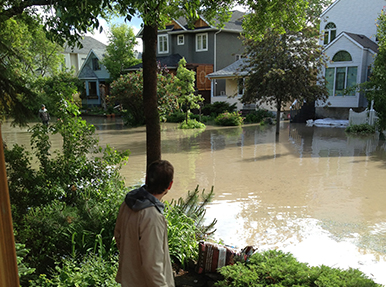
Calgary's 2013 flood is a fading memory for many people, but it's top of mind for students, faculty and staff in the Faculty of Environmental Design as they examine ways to build safer and more resilient communities.
The work mould expert Tang G. Lee has done is one example of the Faculty's ongoing commitment to flood resilience. As a public service in the post-flood era, Lee – a professor who conducts investigations to determine how air quality affects occupant health – tackled particularly complex mould cases for homeowners who had difficulty finding experts. Mould, he says, is everywhere in our environment but it takes water to make it grow and cause rot. Moulds also need "food" such as building materials, paper and cloth to eat, which leads to rot.
Lee was also involved with the City of Calgary's Flood Mitigation Committee which was established after the June 2013 flood to anticipate and mitigate flood damage. The committee's report has been completed but hasn't yet gone to City Council.
Meanwhile, Joshua Taron, an associate professor of architecture, and architecture graduate student Ryan Cook are working to harness the energy of the materials flowing within flood waters for alternative purposes.
"By modifying existing floodplains-- and the interactions between static landscape forms and flows of materials – we are attempting to reduce the impact of floods on urban areas, and increase the aesthetics of the landscape at the same time," says Taron.
Dean Nancy Pollock-Ellwand says, "The flood revealed our vulnerability – and also our strengths – as a community. The University was a source of needed help during that difficult time and is also a source of expertise that provides some hope as we look toward building more resilient communities."
Click here to read the rest of the article by Vicki Barrett in UToday.
Image courtesy Linda Grandinetti

